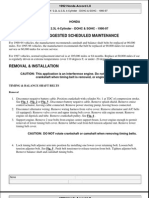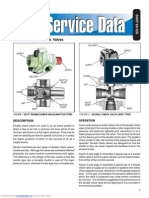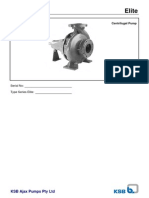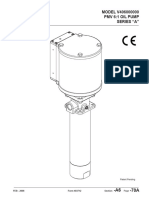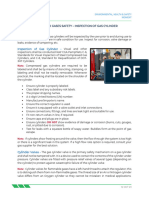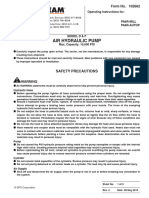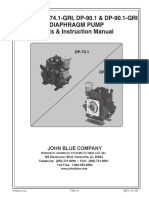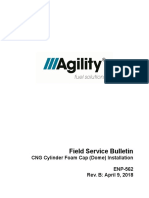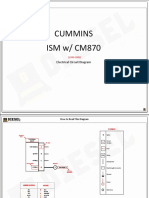Service Information: October/04 II 25 01/04
Service Information: October/04 II 25 01/04
Uploaded by
Marcelo GiussaniCopyright:
Available Formats
Service Information: October/04 II 25 01/04
Service Information: October/04 II 25 01/04
Uploaded by
Marcelo GiussaniOriginal Title
Copyright
Available Formats
Share this document
Did you find this document useful?
Is this content inappropriate?
Copyright:
Available Formats
Service Information: October/04 II 25 01/04
Service Information: October/04 II 25 01/04
Uploaded by
Marcelo GiussaniCopyright:
Available Formats
service information
Date: October/04 Distribution: II Substitues: Gr.: 25 Nr.: 01/04
if
Failure diagnosis in clutch drive master cylinders
Commercial vehicles
This circular letter has the scope to emphasize the importance of the correct bleeding of the hydraulic system in
order to obtain correct diagnoses, avoiding unnecessary replacement of clutch system components. Example:
master cylinders.
IMPORTANT: Before starting any job in the vehicle, be sure all required safety measures are followed as stated in
the “S.I. - Service and Safety - Gr.: 00 - Number: 01/91”.
PROCEDURES
The bleeding of the clutch hydraulic system consists in purging the air contained inside the clutch drive system
(cylinder and piping) replacing the air with brake fluid.
Procedures with the bleeding apparatus.
Follow the manufacturer’s instructions.
1 - Remove the fluid reservoir cap and attach the connecting piece of the
bleeding apparatus (1).
Example
DAIMLERCHRYSLER DO BRASIL LTDA. IN WHOLE OR PARTIAL REPRODUCTION
PROHIBITED WITHOUT PREVIOUS
WRITTEN AGREEMENT
S.I. 25 - 01/04
Page 02
2 - Adjust bleeding apparatus pressure to 1 bar.
3 - Lift off the protective cover and attach a transparent hose to the bleed-
ing bolt (arrow) to the slave cylinder.
• Remark: The brake fluid is not to be reused. Catch the fluid in a
suitable container and dispose it in an environmental way accord-
ing to the rules in force.
4 - Operate the bleeding apparatus until the brake fluid reaches the mini- Aparelho de sangria
mum level in the reservoir.
5 - Loosen the bleeding bolt and keep it loose until the brake fluid coming
off the transparent hose no longer contains air bubbles.
6 - Shut the bleeding bolt and depress the clutch pedal 3 to 5 times, keep-
ing it depressed in the last operation.
7 - Loosen the bleeding valve once again and check if there are any air in
the system. Example
8 - If air is detected coming off the hose after a few seconds, repeat procedures 5, 6 and 7.
9 - After confirming that there is no air in the system, tighten the bleeding bolt and detach the transparent hose,
relieve the pressure in the machine and detach the hose at the expansion reservoir.
Remarks:
• Check the brake fluid level in reservoir. Replenish if necessary.
• Use specified brake fluid.
Procedures without the bleeding apparatus.
1 - Check if the brake fluid in reservoir is at maximum level. Replenish if necessary.
Remarks:
• During the bleeding procedure the brake fluid level should not be allowed to get below the minimum level.
• Use specified brake fluid.
2 - The compressed air tanks in vehicle must be charged.
3 - Lift off the protective cover and attach a transparent hose to the bleed-
ing bolt (arrow) to the slave cylinder.
• Remark: The brake fluid is not to be reused. Catch the fluid in a
suitable container and dispose it in an environmental way accord-
ing to the rules in force.
4 - Depress the clutch pedal from 7 to 10 times holding it depressed in the
last operation.
Exemplo
5 - Loosen and tighten the bleeding bolt quickly checking at the transparent
S.I. 25 - 01/04
Page 02
hose if there is air in the system.
6 - If air bubbles are detected, repeat procedures 4 and 5 until its elimination.
Post bleeding procedures in case the results in the clutch system are not satisfactory.
1 - Check the positioning and conditions of the hydraulic master cylinder:
• The piston, when at rest, must be positioned at the snap-ring close to the face of the cylinder, and it should
not contain debris nor grease.
1 - Cylinder; 5 - Retaining ring;
2 - Snap-ring; 6 - Bellows;
3 - Spring; 7 - Rod;
4 - Piston with packings; A - Correct piston facing
NOTE: The cylinder piston in rest position must not be positioned along its stroke, as it is pushed by spring force
to its rest position.
• For the eventual cleaning of the master cylinder we recommend the use of ethyl alcohol, do not use gasoline,
solvents or paint thinner.
NOTE: Do not use the alcohol for more than 30 minutes to avoid drying out the packings.
• If there are traces of oxidation in the cylinder, use a fine sponge. Should the oxidation persist, replace the cyl-
inder.
2 - After carrying out the above steps, the clutch system should operate correctly. Should the fault persist, check
the connections, lines, slave cylinder and consequently the clutch disc and the clutch press plate. To obtain more
information refer to instructions in the SELiT (Electronic System of Technical Literature).
MERCEDES-BENZ
After-Sales
You might also like
- Twin Cylinder OHV BRIGGS & STRATTON PDFDocument101 pagesTwin Cylinder OHV BRIGGS & STRATTON PDFigrekqa100% (13)
- Stihl FS 130 Manual PDFDocument12 pagesStihl FS 130 Manual PDFGrundfos1989100% (2)
- Honda Accord TimingDocument9 pagesHonda Accord Timingsting30100% (1)
- 2 - Canrig Top Drive Rig Crew TrainingDocument104 pages2 - Canrig Top Drive Rig Crew TrainingDiego Fabian Ruiz Vacaflor90% (10)
- AP Lockheed Remote Servo ManualDocument8 pagesAP Lockheed Remote Servo Manualjblodwell100% (1)
- Saab Official Service Manual: 900 16 Valve: 1985-1993 - ExcerptDocument2 pagesSaab Official Service Manual: 900 16 Valve: 1985-1993 - ExcerptBentley PublishersNo ratings yet
- Plunger Pump ManualDocument23 pagesPlunger Pump Manualgovindharajalu75% (4)
- Clutchmastercylinder Installation InstructionsDocument1 pageClutchmastercylinder Installation Instructionsaliajordan41No ratings yet
- I and O-1012 - 1014 - 1015 - and 1017 Pumps 1-1Document9 pagesI and O-1012 - 1014 - 1015 - and 1017 Pumps 1-1Mo'men AdelNo ratings yet
- Cylinder Leakage Tester 2 - Gauge Vse2020.V3: 1. SafetyDocument2 pagesCylinder Leakage Tester 2 - Gauge Vse2020.V3: 1. Safetyhotmaail4No ratings yet
- Fitting Steering Pump SpidDocument15 pagesFitting Steering Pump SpidJuan GarcNo ratings yet
- Clu 1201Document1 pageClu 1201Aleix RamirezNo ratings yet
- MODEL V305000000 PMV 5:1 Oil Pump Series "A": Form 404421 MAR - 2012 SectionDocument12 pagesMODEL V305000000 PMV 5:1 Oil Pump Series "A": Form 404421 MAR - 2012 SectionFaidh Maulana Aksyar FaidhNo ratings yet
- Belt Filter PressDocument5 pagesBelt Filter PressMaku RajkumarNo ratings yet
- Valvula Doble Cheque DC-4 Bendix Manual de ServicioDocument4 pagesValvula Doble Cheque DC-4 Bendix Manual de Serviciojgomez30No ratings yet
- Maintenance and Repair InstructionsDocument12 pagesMaintenance and Repair InstructionsDhananjay NilkuteNo ratings yet
- Automatic Transaxle ServicingDocument28 pagesAutomatic Transaxle ServicingpowerlabdieselsolutionsNo ratings yet
- Pump-Elite - Operating InstructionsDocument12 pagesPump-Elite - Operating Instructionsbookslover1No ratings yet
- PG1203Document17 pagesPG1203heriberto8280No ratings yet
- Cd250 Operation ManualDocument29 pagesCd250 Operation ManualThethanh PhamnguyenNo ratings yet
- Handbook Sealweld Valvulas de ProcesoDocument92 pagesHandbook Sealweld Valvulas de Procesofelipe castellanosNo ratings yet
- Forklift MaintenanceDocument11 pagesForklift MaintenanceTrường NguyenNo ratings yet
- Centrifugal Pump Checklist 2023Document7 pagesCentrifugal Pump Checklist 2023Caesar MutizeNo ratings yet
- L V406000000 GogigggDocument12 pagesL V406000000 Gogigggilyaswinduaji014No ratings yet
- MRP-004 - Brake Bleed - S08-001 v6.1Document4 pagesMRP-004 - Brake Bleed - S08-001 v6.1Matt CrossanNo ratings yet
- Holmatro PPU15Document16 pagesHolmatro PPU15riz333No ratings yet
- Centrifugal Pump MaintenanceDocument7 pagesCentrifugal Pump MaintenanceamasrurNo ratings yet
- VSE2020.V2: Cylinder Leakage TesterDocument2 pagesVSE2020.V2: Cylinder Leakage Testerwalson glen CrastaNo ratings yet
- IFRC - Customer Technical Training (RP - CPP2)Document24 pagesIFRC - Customer Technical Training (RP - CPP2)firdausshukri14No ratings yet
- Motion Pro Leak Test 2TDocument1 pageMotion Pro Leak Test 2TLeandro CaraccioliNo ratings yet
- tb9 2300 426 20Document20 pagestb9 2300 426 20Rolando DaclanNo ratings yet
- ENP-652 Cylinder Boss Wear and RepairDocument7 pagesENP-652 Cylinder Boss Wear and RepaireparodiesNo ratings yet
- WALLACH LL100 TWO TRIGGER CRYOSURGICAL UNIT For N2O Instructions For UseDocument8 pagesWALLACH LL100 TWO TRIGGER CRYOSURGICAL UNIT For N2O Instructions For UsePierre Richard MompremierNo ratings yet
- Maintenance ManualDocument32 pagesMaintenance Manualpratik2429No ratings yet
- Bleeding Hydraulics With No Bleeders 1Document1 pageBleeding Hydraulics With No Bleeders 1balmohankNo ratings yet
- A Procedure For Lube Oil FlushingDocument9 pagesA Procedure For Lube Oil FlushingBrosGeeNo ratings yet
- Amsoil Automatic Transmission Flush ProcedureDocument2 pagesAmsoil Automatic Transmission Flush ProcedureThomas JohnsonNo ratings yet
- EHS Moment - Compressed Gases - Inspection of Gas Cylinder - 12 Oct 23Document2 pagesEHS Moment - Compressed Gases - Inspection of Gas Cylinder - 12 Oct 23sanalkumar24No ratings yet
- Maintenance: Outboard CareDocument18 pagesMaintenance: Outboard Careshygal1981100% (1)
- Start Up Form MPDocument5 pagesStart Up Form MPBUDAPESNo ratings yet
- PT 102662 Iom UsDocument5 pagesPT 102662 Iom UsMo ZeroNo ratings yet
- Portatil AmerexDocument8 pagesPortatil AmerexGrillin GmNo ratings yet
- Mercury Maintenance ManualDocument27 pagesMercury Maintenance ManualJens Adam Hedegaard HansenNo ratings yet
- Mirage g4 Gls at ModelDocument3 pagesMirage g4 Gls at ModelSol S.No ratings yet
- Inspection and Overhaul For Reciprocating CompressorDocument79 pagesInspection and Overhaul For Reciprocating CompressorSalik Ali SyedNo ratings yet
- Kbu KBZ1Document4 pagesKbu KBZ1Andrew VNo ratings yet
- Manual For Hand Portable Halon 1211 ExtinguishersDocument8 pagesManual For Hand Portable Halon 1211 ExtinguishersMatthew ShalkNo ratings yet
- Unit Ii Inspection of Piston EngineDocument45 pagesUnit Ii Inspection of Piston Engineraj6062No ratings yet
- LPG MultivalvesDocument55 pagesLPG MultivalvesAPINo ratings yet
- dp7490 Pump ManualDocument16 pagesdp7490 Pump Manualvipequi50No ratings yet
- IB272Document2 pagesIB272Rodney AlvaradoNo ratings yet
- 3088 Instruction Manual (D) - 230911 - 142910Document20 pages3088 Instruction Manual (D) - 230911 - 142910gguadian21No ratings yet
- YWE P250 ManualDocument21 pagesYWE P250 ManualNuriffah Izzah100% (1)
- Instruct For OperationDocument1 pageInstruct For OperationAriel Martinez NNo ratings yet
- Liquid Ring Pump ManualDocument25 pagesLiquid Ring Pump ManualCornelius Toni KuswandiNo ratings yet
- ENP-562 CNG Field Service Bulletin Foam Cap Dome Installation RepairDocument9 pagesENP-562 CNG Field Service Bulletin Foam Cap Dome Installation RepaireparodiesNo ratings yet
- TB018 Cylinder Compression Test v2021Document2 pagesTB018 Cylinder Compression Test v2021Cristhian HuilcapazNo ratings yet
- Air Hydraulic Pump OTC EnglishDocument8 pagesAir Hydraulic Pump OTC EnglishEdSoloNo ratings yet
- Installation and Operation Instructions For Custom Mark III CP Series Oil Fired UnitFrom EverandInstallation and Operation Instructions For Custom Mark III CP Series Oil Fired UnitNo ratings yet
- Diesel Engine Care and Repair: A Captain's Quick GuideFrom EverandDiesel Engine Care and Repair: A Captain's Quick GuideRating: 5 out of 5 stars5/5 (1)
- Caring for your scooter: How to maintain & service your 49cc to 125cc twist & go scooterFrom EverandCaring for your scooter: How to maintain & service your 49cc to 125cc twist & go scooterNo ratings yet
- Service Information: January/00 II 00 01/00Document10 pagesService Information: January/00 II 00 01/00Marcelo GiussaniNo ratings yet
- Service Information: Execution With CapDocument4 pagesService Information: Execution With CapMarcelo GiussaniNo ratings yet
- Service Information: December/99 II 58 10/99Document2 pagesService Information: December/99 II 58 10/99Marcelo GiussaniNo ratings yet
- Service Information: November/98 I 54 09/98Document14 pagesService Information: November/98 I 54 09/98Marcelo GiussaniNo ratings yet
- Service InformationDocument2 pagesService InformationMarcelo GiussaniNo ratings yet
- Service Information: September/98 II 26 07/98Document4 pagesService Information: September/98 II 26 07/98Marcelo GiussaniNo ratings yet
- Service InformationDocument2 pagesService InformationMarcelo GiussaniNo ratings yet
- Service Information: May/98 II 58 03/98Document2 pagesService Information: May/98 II 58 03/98Marcelo GiussaniNo ratings yet
- Service InformationDocument4 pagesService InformationMarcelo GiussaniNo ratings yet
- Service Information: November/98 I 54 13/98Document14 pagesService Information: November/98 I 54 13/98Marcelo GiussaniNo ratings yet
- Service InformationDocument2 pagesService InformationMarcelo GiussaniNo ratings yet
- Service Information: December/99 II 58 09/99Document2 pagesService Information: December/99 II 58 09/99Marcelo GiussaniNo ratings yet
- Service Information: July/97 II 54 - Nº: 02/97 54 10/97Document2 pagesService Information: July/97 II 54 - Nº: 02/97 54 10/97Marcelo GiussaniNo ratings yet
- Service InformationDocument2 pagesService InformationMarcelo GiussaniNo ratings yet
- Service Information: May/97 II 32 01/97Document2 pagesService Information: May/97 II 32 01/97Marcelo GiussaniNo ratings yet
- Service Information: July/97 I 54 09/97Document2 pagesService Information: July/97 I 54 09/97Marcelo GiussaniNo ratings yet
- Service Information: September/98 II 58 04/98Document10 pagesService Information: September/98 II 58 04/98Marcelo GiussaniNo ratings yet
- Service Information: ST ND RD ST STDocument2 pagesService Information: ST ND RD ST STMarcelo GiussaniNo ratings yet
- Service InformationDocument2 pagesService InformationMarcelo GiussaniNo ratings yet
- Service Information: September/96 I 35 06/96Document1 pageService Information: September/96 I 35 06/96Marcelo GiussaniNo ratings yet
- Service InformationDocument2 pagesService InformationMarcelo GiussaniNo ratings yet
- WH5830B1000ZZDocument61 pagesWH5830B1000ZZMarcelo GiussaniNo ratings yet
- Service Information: May/97 I 41 01/97Document2 pagesService Information: May/97 I 41 01/97Marcelo GiussaniNo ratings yet
- Service InformationDocument2 pagesService InformationMarcelo GiussaniNo ratings yet
- October/01 I 26 04/01: NotesDocument2 pagesOctober/01 I 26 04/01: NotesMarcelo GiussaniNo ratings yet
- Service InformationDocument2 pagesService InformationMarcelo GiussaniNo ratings yet
- Service Information: January/00 I 26 04/00Document2 pagesService Information: January/00 I 26 04/00Marcelo GiussaniNo ratings yet
- Service Information: October/04 I 26 06/04Document2 pagesService Information: October/04 I 26 06/04Marcelo GiussaniNo ratings yet
- Service InformationDocument3 pagesService InformationMarcelo GiussaniNo ratings yet
- Service InformationDocument4 pagesService InformationMarcelo GiussaniNo ratings yet
- Venus VectraDocument2 pagesVenus Vectradeepakshi.inNo ratings yet
- Reactive Voltage DroopDocument2 pagesReactive Voltage Droopwagner_guimarães_1No ratings yet
- P2201 Operating Instruction Manual: Low Velocity Powder Actuated Fastening ToolDocument32 pagesP2201 Operating Instruction Manual: Low Velocity Powder Actuated Fastening TooleguillenNo ratings yet
- DatasheetDocument7 pagesDatasheetmohd FaidzalNo ratings yet
- Lista de VentasDocument3 pagesLista de VentasMiguel Eduardo Castillo BlancoNo ratings yet
- High-Performance Silicon-Gate CMOS: Semiconductor Technical DataDocument7 pagesHigh-Performance Silicon-Gate CMOS: Semiconductor Technical DataHiếu Khải Bạch MaiNo ratings yet
- IHome IH5 Home System For Ipod Quick Start Guide enDocument13 pagesIHome IH5 Home System For Ipod Quick Start Guide enRichard RoperNo ratings yet
- LSA Service - MaintenanceDocument53 pagesLSA Service - MaintenanceBoy HaqiNo ratings yet
- Experiment 11Document8 pagesExperiment 11Mihai BogdanNo ratings yet
- Shri A.D.K.Mahila Polytechnic, Mathura: Summer Training ReportDocument46 pagesShri A.D.K.Mahila Polytechnic, Mathura: Summer Training Reportanand011No ratings yet
- Iron Steel RailingsDocument102 pagesIron Steel Railingsaroubi inphoNo ratings yet
- CSE 3201: Microprocessor and MicrocontrollersDocument2 pagesCSE 3201: Microprocessor and Microcontrollersmeenhaz7096No ratings yet
- (1-17) Tricycle Maintenance StrategyDocument17 pages(1-17) Tricycle Maintenance StrategySunday IweriolorNo ratings yet
- Cummins ISM W/ CM870: Electrical Circuit DiagramDocument12 pagesCummins ISM W/ CM870: Electrical Circuit DiagramRuben Dario Valencia Restrepo100% (3)
- PA308 Installation ManualDocument80 pagesPA308 Installation Manualvene333No ratings yet
- BM26 AdvancedDocument4 pagesBM26 AdvancedagengfirstyanNo ratings yet
- Backwash A Sand FilterDocument1 pageBackwash A Sand Filternike_y2kNo ratings yet
- 09-Soft Clutch-System DescriptionDocument3 pages09-Soft Clutch-System DescriptionGrisha Mari KosoyanNo ratings yet
- Mounting Instruction PARENTESI 34298Document9 pagesMounting Instruction PARENTESI 34298FreiestrasseNo ratings yet
- Diodo 1N4148Document7 pagesDiodo 1N4148Jean Pool Quispe EspinozaNo ratings yet
- CM Resuscitaire PPDocument18 pagesCM Resuscitaire PPdavin ochiengNo ratings yet
- Reozje: ModelDocument4 pagesReozje: ModelLuis LunarNo ratings yet
- Technical Data Sheet of Butterfly Valves S.No. Description JWIL Data Vendor Data A General DataDocument3 pagesTechnical Data Sheet of Butterfly Valves S.No. Description JWIL Data Vendor Data A General DataAbhishek sNo ratings yet
- Mã Lỗi Hộp Số Dana TE30500 DRU450Document79 pagesMã Lỗi Hộp Số Dana TE30500 DRU450Nguyễn Văn HùngNo ratings yet
- Intro To ComputersDocument48 pagesIntro To ComputersHera Gab ReodiqueNo ratings yet
- Dynamic Balancing Machines, Soft-Bearing vs. Hard-BearingDocument3 pagesDynamic Balancing Machines, Soft-Bearing vs. Hard-BearingThanaraj SanmughamNo ratings yet
- Experiment No:-: AIM:-To Study The Construction and Working of Earth Leakage Circuit Breaker (ELCB) - TheoryDocument2 pagesExperiment No:-: AIM:-To Study The Construction and Working of Earth Leakage Circuit Breaker (ELCB) - TheoryAnonymous kQpC87iNo ratings yet
- SMPS TT 2022Document115 pagesSMPS TT 2022Kanekii HaiseNo ratings yet


